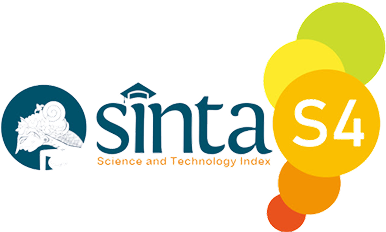Hydrolysis of Solid Waste From Bioethanol Plants into Glucose Using Hydrochloric Acid Catalyst
Keywords:
Carbohydrate, Glucose, hydrolysis, HCl, YieldAbstract
The large amount of solid waste from bioethanol plants is regrettable if it is only used as animal feed. The solid waste has a relatively high carbohydrate content of 36.85%, which has the potential to be hydrolysed to glucose. Hydrolysis with water is slow, so a catalyst is needed to speed up the reaction. HCl hydrolysis is commonly used to convert carbohydrates to glucose. The hydrolysis process in this study involved heating at 95°C with a stirring speed of 300 rpm. The variables tested were hydrolysis time (90, 120, 150, 180, 210 minutes) and HCl concentration (1.5, 2, 2.5, 3, 3.5N). The results showed that hydrolysis time and HCl concentration had a direct effect on glucose yield. The longer the hydrolysis time and the higher the concentration used, the higher the glucose yield. The highest glucose content obtained was 23.12%, with a yield of 70.6%, obtained under the conditions of 210 minutes hydrolysis time and 3.5 N HCl concentration.
References
[1] A. Hidayat, “Ketika Kambing Doyan Campuran Yeast Mud.” [Online]. Available: https://enero.co.id/ketika-kambing-doyan-campuran-yeast-mud/
[2] A. Karlović, A. Jurić, N. Ćorić, K. Habschied, V. Krstanović, and K. Mastanjević, “By-products in the malting and brewing industries-re-usage possibilities,” Fermentation, vol. 6, no. 3, pp. 1–17, 2020, doi: 10.3390/FERMENTATION6030082.
[3] I. A. S. C. Pertiwi, L. P. Wrasiati, and I. W. Arnata, “Pemanfaatan Ampas Padat Brem Cair Menjadi Gula Cair,” J. Rekayasa Dan Manaj. Agroindustri, vol. 4, no. 4, pp. 49–58, 2016.
[4] M. S. Fajri, M. A. Satrio, L. I. Utami, and K. N. Wahyusi, “Produksi Gula Cair dengan Proses Hidrolisis Asam dengan Bahan Pati Singkong,” ChemPro, vol. 3, no. 1, pp. 58–64, 2022, doi: 10.33005/chempro.v3i1.157.
[5] A. P. Mayang, R. P. Sari, and R. Fathoni, “Pembuatan Glukosa Dari Kulit Pisang Kepok (Musa Paradisiaca L.) Dengan Proses Hidrolisis,” J. Integr. Proses, vol. 8, no. 1, p. 39, 2019, doi: 10.36055/jip.v8i1.5608.
[6] G. W. Aniriani, N. F. Apriliani, and E. Sulistiono, “Hydrolysis of Polycoxarida Xylane Straw Using Strong Acid Acid Solution for Basic Materials of Bioetanol Production,” J. Ilm. Sains, vol. 18, no. 2, pp. 113–117, 2018.
[7] N. P. S. Ayuni and P. N. Hastini, “Serat Sabut Kelapa Sebagai Bahan Kajian Pembuatan Bioetanol Dengan Proses Hidrolisis Asam,” JST (Jurnal Sains dan Teknol., vol. 9, no. 2, pp. 102–110, 2020, doi: 10.23887/jst-undiksha.v9i2.29035.
[8] N. N. K. Asih, P. Suarya, I. B. P. Manuaba, and I. N. Wirajana, “Hidrolisis Batang Jagung Secara Enzimatik dari Tanah Hutan Mangrove,” Cakra Kim. (Indonesian E-Journal Appl. Chem., vol. 6, no. 2, pp. 106–115, 2018.
[9] N. K. A. Dewi, A. Hartiati, and B. A. Harsojuwono, “Pengaruh Suhu Dan Jenis Asam Pada Hidrolisis Pati Ubi Talas (Colocasia esculenta L. Schott) Terhadap Karakteristik Glukosa,” J. Rekayasa Dan Manaj. Agroindustri, vol. 6, no. 4, p. 307, 2018, doi: 10.24843/jrma.2018.v06.i04.p05.
[10] N. Lisin, G. S. Hutomo, and S. Kadir, “Hidrolisis Selulosa Dari Pod Husk Kakao Menggunakan Asam Sulfat,” e-J. Agrotekbis, vol. 3, no. 4, pp. 482–490, 2015.
[11] E. Kriswiyanti, “Pengaruh Jenis Dan Konsentrasi Asam Terhadap Kinetika Reaksi Hidrolisis Pelepah Pisang (Musa Paradisiaca L),” Ekuilibium, vol. 11, no. 2, pp. 73–77, 2012, doi: 10.20961/ekuilibrium.v11i2.2216.
[12] I. Inayati, “Pengaruh Waktu Hidrolisa Dan Konsentrasi Asam Pada Hidrolisa Pati Kentang Dengan Katalis Asam,” Ekuilibium, vol. 13, no. 2, pp. 45–49, 2014, doi: 10.20961/ekuilibrium.v13i2.2158.
[13] A. D. Safitri et al., “Glukosa Cair Dari Proses Hidrolisis Ubi Jalar Kuning (Ipomoea Batatas L) Menggunakan Katalis Asam Klorida,” Chem. Eng. J. Storage, vol. 2, no. 4, p. 81, 2022, doi: 10.29103/cejs.v2i4.7729.
[14] Y. Yustinah, U. H. Hasyim, A. B. Syamsudin, and ..., “Pengaruh Konsentrasi Asam Sulfat Pada Proses Hidrolisis Dedak Padi Menjadi Glukosa Untuk Pembuatan Plastik Biodegradabel,” Pros. …, no. 2460 – 8416, pp. 1–5, 2018, [Online]. Available: https://jurnal.umj.ac.id/index.php/semnastek/article/view/3587
[15] S. Ma’mun, A. Rochmaningsih, R. Nabila, and A. Sumalyani, “Determination of Reducing Sugar Groups from Hydrolysis of Arthrospira platensis Microalgae using Microwaves,” Jurnal.Unej.Ac.Id, vol. 12, no. 2, pp. 57–63, 2024, doi: 10.19184/bst.v12i.2.47304.
Downloads
Published
Issue
Section
License
Copyright (c) 2024 Mochammad Rifqi Ardiansyah, Nashrul Haqqi, Sani (Author)

This work is licensed under a Creative Commons Attribution 4.0 International License.












